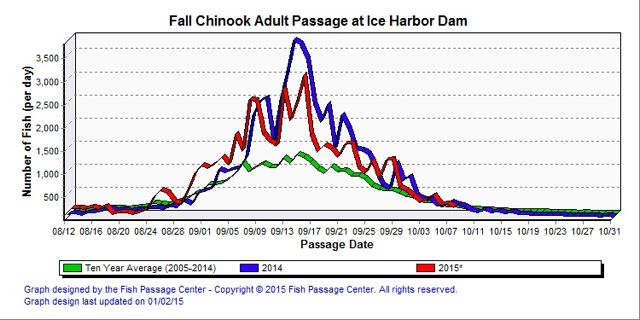forum
library
tutorial
contact

That Certainly Is a Lot of
Chinook at Bonneville Dam!
by Coby Hutzler
Willamette Week, November 13, 2015
|
the film forum library tutorial contact |

|
That Certainly Is a Lot of
by Coby Hutzler
|
It's a 77-year record, actually

 Things are looking up for chinook salmon.
Things are looking up for chinook salmon.
Fish counting at Bonneville Dam revealed Nov. 10 that the number of adult chinook crossing the dam on their way back to spawning grounds reached a 77-year record 953,240 fish for the year. The dam is 45 minutes east of Portland on the Columbia River.
Stuart Ellis, a harvest management biologist with the Columbia River Inter-Tribal Fish Commission, said that heavier-than-usual river flows helped these same salmon make it down the river to the ocean four or five years ago.
Chinook, which spend their first three months to two years in freshwater, live at sea for between one and six years before returning upstream to spawn, according to the National Oceanic and Atmospheric Administration.
Ellis said that favorable ocean conditions, such as an abundant food supply and optimum level of predators, contributed to the high return count.
"The balance of that is that the longer you can stay in the ocean in the summer before you come in, the more you can eat and the bigger you can get," Ellis said, adding that the larger the salmon are, the more eggs they can eventually lay.
"The fall chinook also benefited from tribal efforts using hatcheries to rebuild naturally spawning populations throughout the Columbia River Basin, harvest management actions on the Pacific Ocean and mainstem Columbia, and strong collaborative efforts to improve habitat," the commission's statement said.
The new record comes on the heels of a move by the Oregon Board of Forestry to expand no-logging buffers along streams on private land, in an effort to increase shade and keep streams' temperatures down, the Associated Press reports.
Ellis said that warmer streams can lead to illnesses--like bacterial and fungal infections--in some other species of salmon. But chinook, he said, aren't as susceptible to warmer water.
"They're just naturally a bit better adapted to it," he said.
The high counts are also good news for the Native American tribes living along the Columbia.
"Fall chinook for the tribes has always been the economic backbone for these communities," says Sara Thompson, a spokeswoman for the commission.
"It's an important component of the tribal economy, and the local economy."
learn more on topics covered in the film
see the video
read the script
learn the songs
discussion forum
